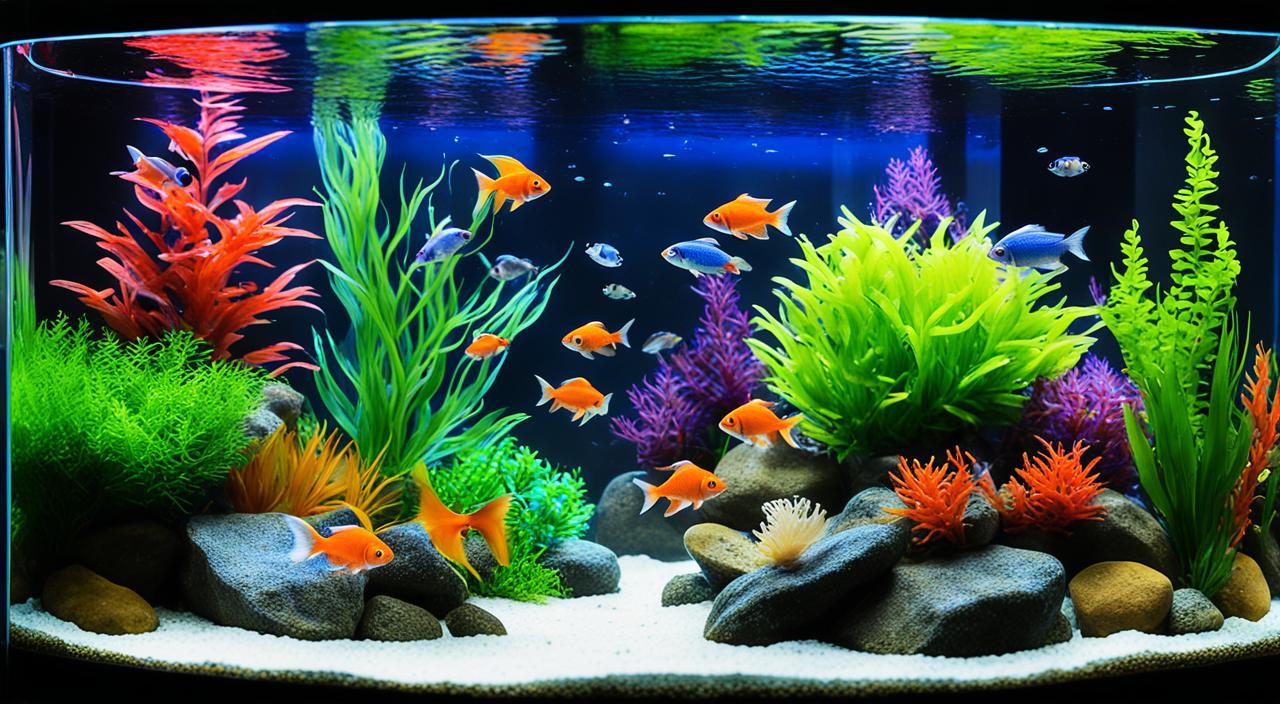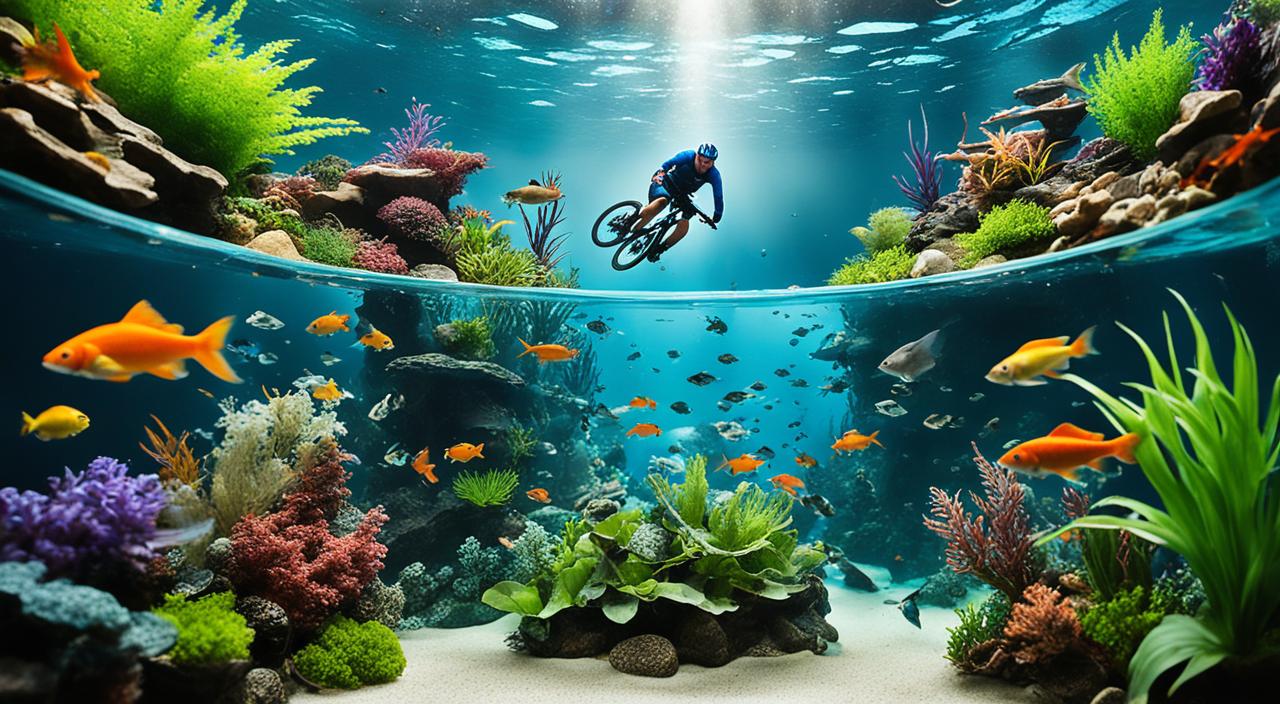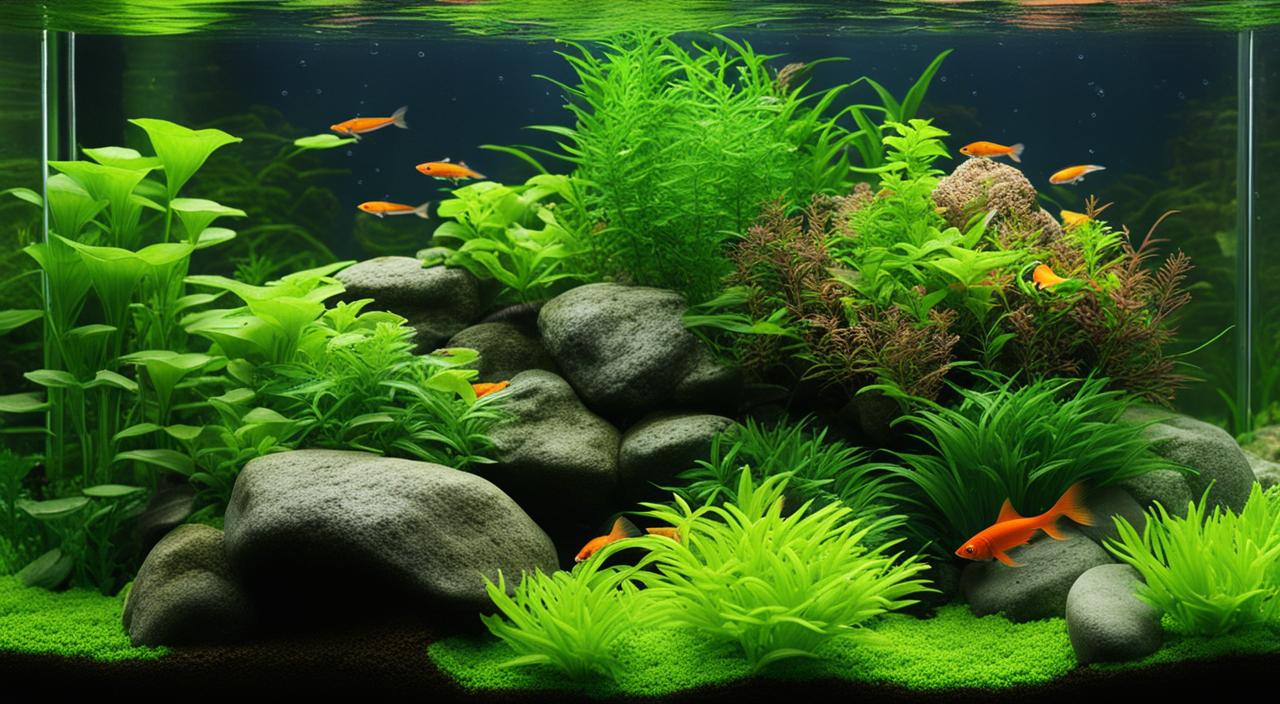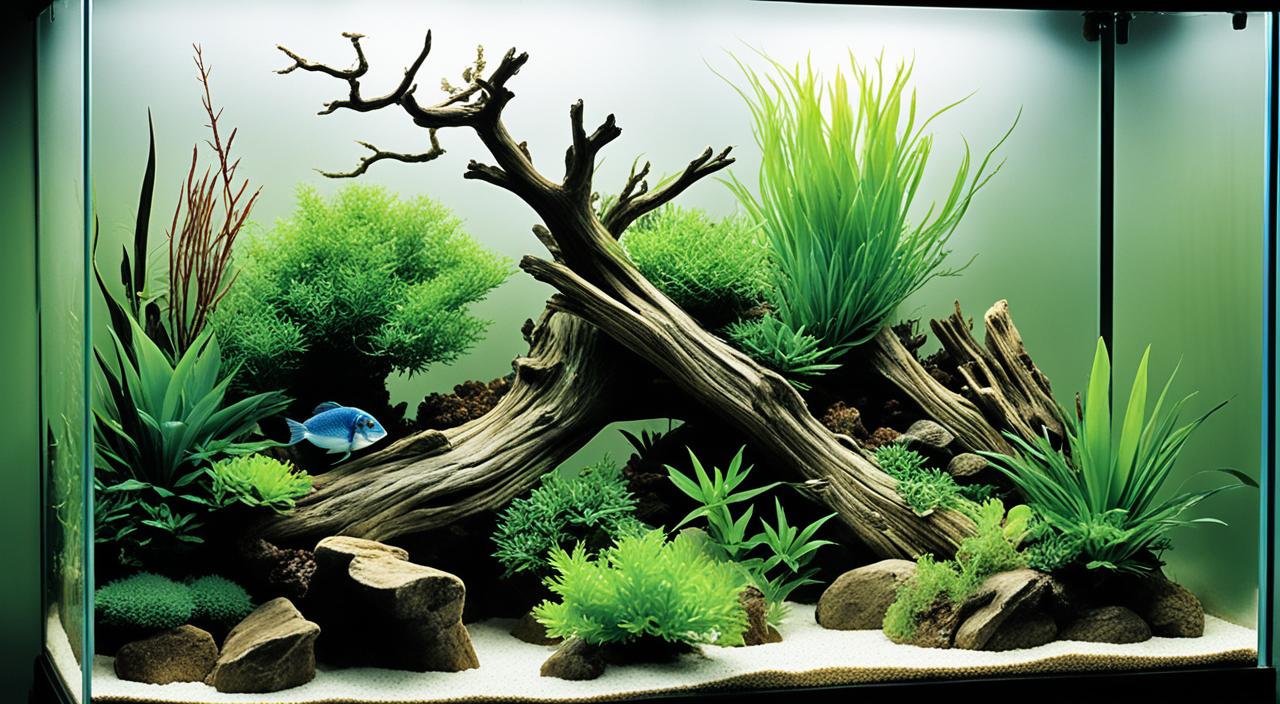Cycling an aquarium is a crucial step to ensure the long-term health of fish. Adding fish to an uncycled tank can lead to ammonia poisoning and fish deaths. Testing the water for ammonia, nitrite, and nitrate levels is essential to determine if the tank has completed the cycling process. A cycled tank will have zero ammonia and nitrite levels and nitrates below 30 ppm. It typically takes four to six weeks for a new tank to cycle fully. It’s important to continue testing the water until the levels meet the criteria for a cycled tank.
Key Takeaways:
- A fully cycled tank will have zero ammonia and nitrite levels and nitrates below 30 ppm.
- Testing the water for ammonia, nitrite, and nitrate levels is essential to determine if the tank has completed the cycling process.
- The cycling process typically takes four to six weeks for a new tank.
- Continued water testing is crucial until the levels meet the criteria for a cycled tank.
- A cycled tank provides a safe and healthy environment for fish, preventing ammonia poisoning and fish deaths.
The Importance of Proper Aquarium Cycling
Proper aquarium cycling is crucial for maintaining the health and well-being of your fish. Failing to cycle your tank can have serious consequences, including ammonia poisoning and fish deaths. To ensure a safe and stable environment for your fish, it’s essential to understand the benefits of a cycled tank and the importance of water testing and maintenance.
A cycled tank provides a natural biological filtration system that breaks down harmful substances, such as ammonia and nitrites, into less toxic nitrates. This process is facilitated by beneficial bacteria colonising tank surfaces and filtering media. By allowing the tank to cycle correctly, you create an environment that prevents the accumulation of toxic compounds and promotes the overall health of your fish.
Regularly testing the water parameters is vital to maintaining a cycled tank. Ammonia and nitrite levels should be consistently zero, while nitrate levels should remain below 30 ppm. Regular water testing allows you to monitor these levels and take appropriate action if any changes occur, preventing any harm to your fish.
The duration of the new tank cycling process can vary, but it generally takes four to six weeks for the beneficial bacteria to establish and the tank to fully cycle. During this time, it’s essential to be patient and continue testing the water until the tank meets the criteria for a cycled tank.
By properly cycling your aquarium, you are ensuring the long-term health and well-being of your fish. A cycled tank creates a stable and ideal living environment, minimizing the risk of ammonia poisoning and fish deaths. Regular water testing and maintenance are necessary to maintain the optimal fish health that a cycled tank provides.
Remember, the journey to a cycled tank may take some time, but the rewards are well worth the effort. Your fish will thrive in a healthy and sustainable aquatic ecosystem.
Next, we will explore methods to speed up the aquarium cycling process and reduce the time it takes for your new tank to cycle fully.
Methods to Speed Up the Aquarium Cycling Process
If you’re eager to reduce the cycling time of your aquarium and get it ready for your fish sooner, you can employ several effective methods. These techniques can help speed up the cycling process and create a healthy environment for your aquatic pets.
1. Aquarium Bacteria Supplement
One way to accelerate the colonization of beneficial bacteria in your tank is by using an aquarium bacteria supplement. These supplements contain live bacteria cultures that can jumpstart the cycling process. Follow the instructions provided with the supplement to introduce the bacteria to your tank and promote the growth of a healthy bacterial colony.
2. Using Established Filter Media
Another method to expedite the cycling process is introducing established filter media from an existing cycled tank. This media already contains a robust population of beneficial bacteria, which can significantly reduce the time it takes for your aquarium to cycle. Place the established filter media in your new tank’s filter system to jumpstart the colonization of bacteria and create a stable environment for your fish.
3. Adding Live Plants
Incorporating live plants into your aquarium enhances its visual appeal and provides additional surfaces for growing beneficial bacteria. These plants absorb nutrients, including nitrates, from the water, making it easier to maintain optimal water quality. The presence of live plants can help speed up the cycling process by fostering the growth of beneficial bacteria and balancing the nitrogen cycle.
4. Controlling Water Temperature
Optimizing the water temperature in your aquarium can also accelerate the growth and reproduction of beneficial bacteria. Maintaining a consistent and appropriate temperature range, usually between 78-82°F (25-28°C), creates an ideal environment for bacterial colonization. A heater with a built-in thermostat can help keep the water temperature within the desired range and promote a faster cycling process.
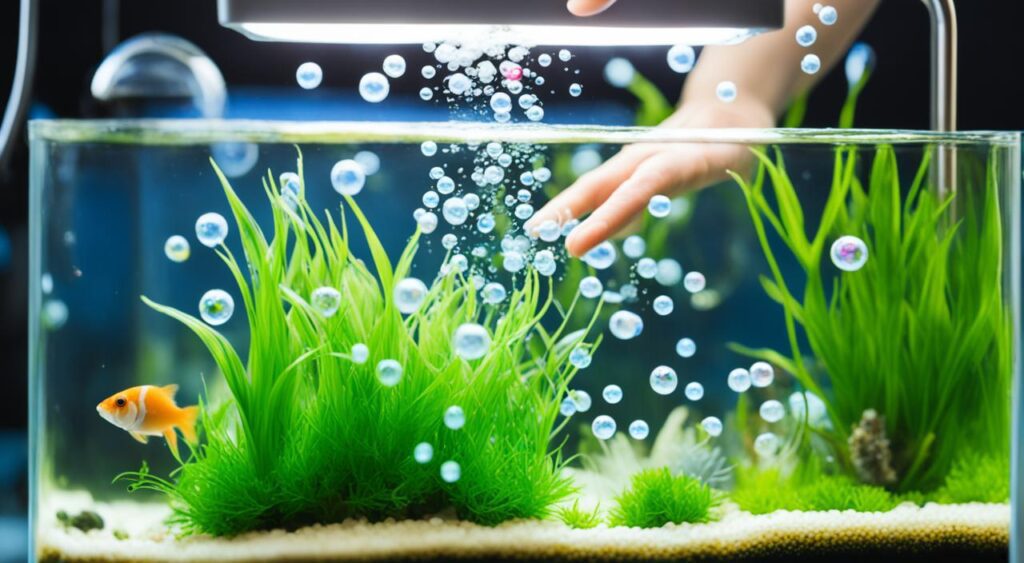
| Methods to Speed Up Aquarium Cycling | Effectiveness | Difficulty Level | Benefits |
|---|---|---|---|
| Aquarium Bacteria Supplement | High | Low | Accelerates bacterial colonization and cycling process. |
| Using Established Filter Media | High | Low | Introduces established bacteria colony and jumpstarts cycling. |
| Adding Live Plants | Moderate | Medium | Provides additional surface area for beneficial bacteria growth. |
| Controlling Water Temperature | Moderate | Medium | Promotes faster bacterial growth and reproduction. |
Common Mistakes to Avoid During the Aquarium Cycling Process
When cycling an aquarium, there are common mistakes that aquarists should avoid to ensure a successful and healthy cycling process. Understanding and avoiding these mistakes can create a stable and thriving environment for your fish.
Mistake 1: Neglecting pH Levels
Maintaining proper pH levels is crucial during the aquarium cycling process. A pH below 7.0 can slow down or even stall the nitrogen cycle. Regularly monitor the pH levels using a reliable test kit and make necessary adjustments if the pH is too low or high.
Mistake 2: Ignoring Ammonia Levels
Ammonia is a toxic compound that can harm the beneficial bacteria cycling your aquarium. Excessive ammonia levels can inhibit the growth of these bacteria and slow down the cycling process. Perform regular water tests to monitor the ammonia levels and take immediate action if they are too high.
Mistake 3: Overfeeding Fish
Overfeeding fish is a common mistake that can lead to an overload of organic waste in the tank. The excess food breaks into ammonia, which can spike the ammonia levels and disrupt the cycling process. Follow the recommended feeding guidelines for your fish species to avoid overfeeding and maintain a balanced nitrogen cycle.
Mistake 4: Overcrowding the Tank
Overcrowding the tank with too many fish can result in excessive waste production. The filtration system may be unable to keep up with the high levels of ammonia and nitrites, leading to poor water quality and fish stress. Avoid overcrowding by researching suitable fish compatibility and tank size requirements before adding new fish.
Common Mistakes to Avoid During Aquarium Cycling Process
When cycling an aquarium, one must be aware of common mistakes that can hinder the process. Understanding and preventing these mistakes can ensure a smooth and successful cycling process with optimal water conditions for your fish.
Mistake 1: Neglecting pH Levels
The ideal pH range for most tropical fish species is between 6.8 and 7.5. Failure to monitor and maintain proper pH levels can disrupt the nitrogen cycle and hinder the growth of beneficial bacteria. Test the pH regularly using a reliable test kit and make any necessary adjustments to keep it within the appropriate range.
Mistake 2: Ignoring Ammonia Levels
Excessive ammonia levels can be harmful to both fish and beneficial bacteria. High ammonia levels can lead to stress, diseases, and even fish deaths. Regularly test the water for ammonia and immediately act if levels become elevated. Performing partial water changes can help dilute ammonia concentrations and maintain a healthy cycling process.
Mistake 3: Overfeeding Fish
Overfeeding fish can lead to an increase in ammonia production. Uneaten food and fish waste contribute to elevated ammonia levels, which can slow down and disrupt the cycling process. Feed your fish in moderation, considering their specific dietary needs, to minimize excess waste and maintain water quality.
Mistake 4: Overcrowding the Tank
Adding too many fish to a newly cycled tank can overload the biological filtration capacity, increasing ammonia and nitrite levels. Avoid overcrowding by researching the appropriate stocking levels for your tank size and species. Consider the fish’s adult size and territorial nature to prevent stress and maintain a healthy cycling process.
| Common Mistakes | Effects | Prevention |
|---|---|---|
| Neglecting pH Levels | Disruption of nitrogen cycle | Monitor and adjust pH regularly |
| Ignoring Ammonia Levels | High ammonia toxicity, fish stress and diseases | Frequent ammonia testing and water changes |
| Overfeeding Fish | Elevated ammonia levels, poor water quality | Feed in moderation and remove excess food |
| Overcrowding the Tank | Increased ammonia and nitrite levels, fish stress | Research stocking levels and tank size requirements |
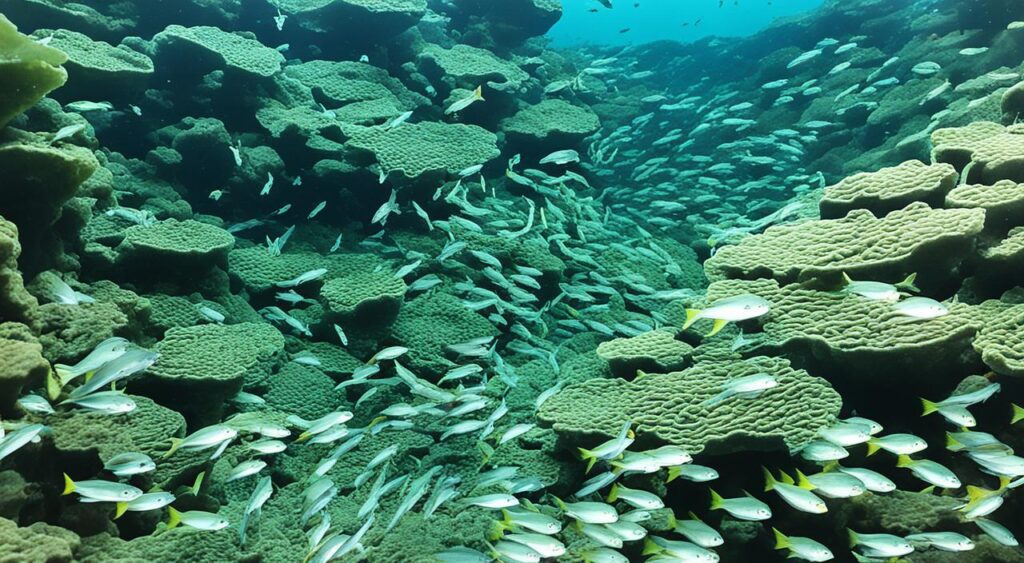
The Nitrogen Cycle and its Significance in Aquarium Cycling
The nitrogen cycle is a crucial process in aquarium cycling. It involves the conversion of harmful compounds like ammonia and nitrites, produced from fish waste and decaying matter, into less toxic nitrates. This cycle is facilitated by beneficial bacteria that colonize the biological filter media and various surfaces in the tank.
Ammonia, which is highly toxic to fish, is metabolized into nitrites by Nitrosomonas bacteria. Nitrites are also toxic to fish. However, Nitrobacter bacteria metabolize nitrites into nitrates, which are relatively less harmful.
This biological filtration provided by beneficial bacteria is essential for maintaining water quality and creating a healthy environment for fish. The presence of these bacteria helps prevent the buildup of toxic compounds and ensures the overall well-being of the aquarium inhabitants.
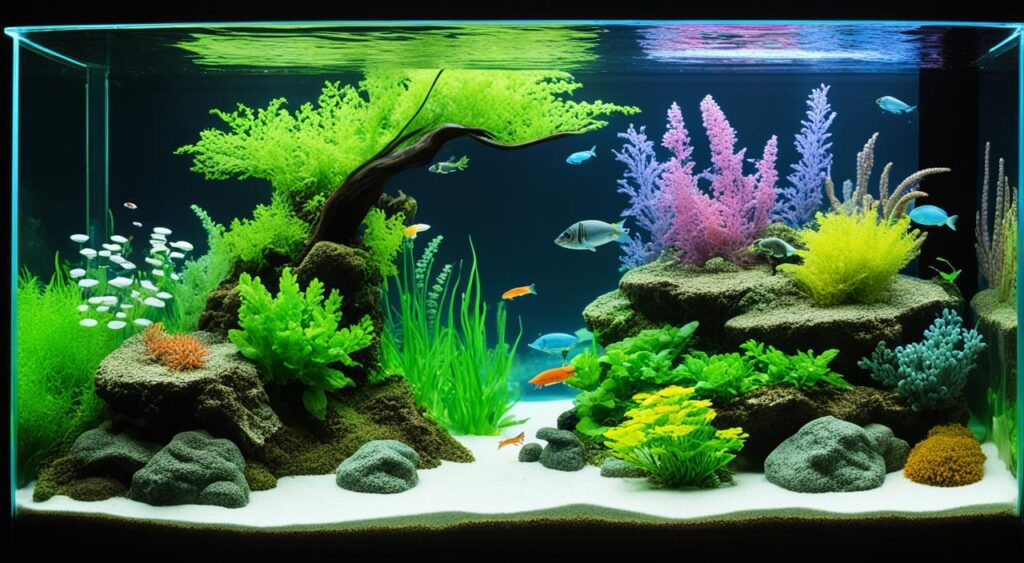
| Compound/Stage | Description |
|---|---|
| Ammonia | Produced from fish waste, uneaten food, and decaying matter |
| Nitrosomonas Bacteria | Metabolizes ammonia into nitrites |
| Nitrites | Highly toxic to fish |
| Nitrobacter Bacteria | Metabolizes nitrites into nitrates |
| Nitrates | Less toxic but can still be harmful in high concentrations |
Fishless Cycling vs. Cycling with Fish
Regarding aquarium cycling, there are two main methods to choose from: fishless cycling and cycling with fish. Each method has its pros and cons, and it’s essential to understand them before deciding which approach to take.
Fishless Cycling
Fishless cycling involves creating a favourable environment for beneficial bacteria to establish themselves in the aquarium without fish. This method utilizes an ammonia source to provide food for the bacteria, allowing them to grow and convert the toxic ammonia into less harmful substances.
A few ways exist to introduce ammonia into the tank for fishless cycling. One option is to use pure ammonia, found in stores, as an ammonia-cleaning solution. Another method is adding decaying fish food or a piece of raw shrimp to the tank, releasing ammonia as it decomposes.
Using fishless cycling has several advantages. Firstly, it eliminates the potential harm and stress to fish during cycling. It also allows more precise control over the cycling timeline and water parameters. Additionally, fishless cycling is considered a more humane approach, as it prioritizes the well-being of the fish.
Monitoring the ammonia, nitrite, and nitrate levels is crucial to the fishless cycle in your aquarium. This will help you determine when the cycling process is complete and if the tank is safe for fish. Patience is vital, as fishless cycling can take several weeks to complete.
Cycling with Fish
The alternative to fishless cycling is cycling with fish. This method involves adding hardy fish, such as zebra danios, to the aquarium to kick-start the cycling process. The waste produced by these fish serves as an ammonia source, which triggers the growth of beneficial bacteria.
While cycling with fish can provide some immediate action in the tank, it does come with certain risks and drawbacks. Firstly, the fish may experience stress and potentially reduced lifespans due to fluctuating water conditions during cycling. Secondly, controlling ammonia and nitrite levels can be more challenging, as the presence of fish can result in higher and more unstable levels of these toxic compounds.
Fishless cycling is generally considered a more controlled and humane method for establishing a healthy and stable aquarium environment. It allows for better regulation of water parameters and avoids potential cruelty to fish. However, if you choose to cycle with fish, it’s important to closely monitor water parameters, perform regular water changes, and provide appropriate care for the fish during the process.
| Method | Advantages | Disadvantages |
|---|---|---|
| Fishless Cycling |
|
|
| Cycling with Fish |
|
|
Adding Livestock to a Cycled Aquarium
Now that your aquarium has completed the cycling process, it’s time to introduce fish to their new home. However, it’s essential to proceed with caution and take the necessary steps to ensure the health and well-being of your fish. The gradual introduction is critical to preventing the biological filtration system from becoming overwhelmed.
Start by adding a few small and hardy fish to the tank. This allows you to monitor the water quality and make necessary adjustments closely. Regularly test the water for ammonia, nitrites, and nitrates to ensure they remain at appropriate levels. Maintaining optimal water parameters is crucial for the overall health of your fish.
Avoid overcrowding the tank, as this can lead to poor water quality and stress for the fish. It’s essential to resist adding too many fish too quickly. Overfeeding the fish can also contribute to water quality issues, so be mindful of their dietary needs and feed them appropriately.
Additionally, be prepared to perform regular water changes to keep the tank environment pristine. Water changes help remove accumulated waste and toxins, ensuring a thriving aquarium. Following these guidelines for adding livestock to a cycled aquarium, you can create a safe and thriving habitat for your fish.
FAQ
What are the signs of a completed aquarium cycle?
The indicators of a completed aquarium cycle include zero levels of ammonia and nitrites in the water, and nitrates below 30ppm.
Why is proper aquarium cycling important?
Proper aquarium cycling is crucial for the health and well-being of fish, as adding fish to an uncycled tank can lead to ammonia poisoning and fish deaths.
How can I speed up the aquarium cycling process?
There are several methods to speed up the aquarium cycling process, such as adding a bacteria supplement, using established filter media, adding live plants, and controlling water temperature.
What are some common mistakes to avoid during the aquarium cycling process?
Common mistakes to avoid include neglecting to monitor and maintain pH levels, allowing excessive ammonia levels, overfeeding fish, and overcrowding the tank.
What is the significance of the nitrogen cycle in aquarium cycling?
The nitrogen cycle is a crucial process in aquarium cycling where beneficial bacteria convert harmful compounds like ammonia and nitrites into less toxic nitrates, promoting water quality and fish health.
What are the differences between fishless cycling and cycling with fish?
Fishless cycling involves using an ammonia source to promote bacterial growth, while cycling with fish introduces hardy fish to start the cycling process. Fishless cycling is generally considered more humane and controlled.
When is it safe to add fish to a cycled aquarium?
Once the aquarium has completed the cycling process, it is safe to start adding fish. However, it is crucial to introduce fish gradually to avoid overwhelming the biological filtration system.

